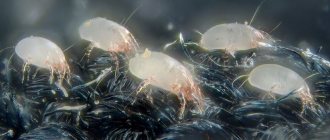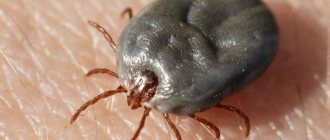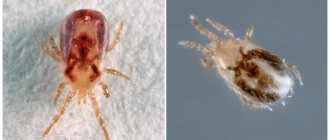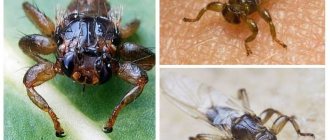Types of ticks
About 50,000 species of different ticks live on the planet. Moreover, this list is constantly updated, since etymology as a science does not stand still. Conventionally, ticks can be divided into two main categories. The first is parasitic ticks, those that feed on the blood of other creatures. The second is acariform mites - all other types of mites are also not always harmless. These include: dust mites, sea mites, hair mites, scabies and other types of mites.
The most prominent representative of parasitic ticks is the ixodid tick. It is he who causes the greatest concern among city dwellers who are planning to get out of the concrete jungle for the weekend into the bosom of Nature. Fear forces very suspicious people to give up going to the forest and even the park. Perhaps a closer acquaintance with this “monster” will help relieve excessive anxiety and understand that not a single tick in the world has the right to deprive a person of a breath of fresh air and necessary rest. So, who is the ixodid tick and how to fight it.
Ticks (general description, lifestyle)
Ticks (Fig. 23.7) are small arachnids, united in several orders. The body length of mites usually does not exceed 1 mm. They live mainly in soil and grass. Most soil mites feed on plant debris and microorganisms. Their mouthparts are adapted for grinding food.
Among ticks there are also parasitic species. In most parasitic ticks, the oral apparatus is modified; it has a proboscis, with which the animal pierces the skin and sucks out the liquid contents (Fig. 23.8).
Unlike other spiders, mites have a cephalothorax and abdomen that merge into one whole. They breathe with the help of tracheas, and the smallest species breathe with the entire surface of the body. The development of mites occurs with transformation. A larva with three pairs of legs first emerges from the egg. Another pair of legs appears in the next larval stage. After several molts, this larva turns into an adult tick.
| Rice. 23.7. Mites: velvet mites (a), ixodid mites (b), scabies mites (c) |
| Rice. 23.8. Mouthparts of a parasitic tick |
Some types of mites are pests of cultivated plants. These include very small (0.3-0.4 mm) spider mites that live in large clusters on the lower surface of leaves. Granary mites often live in granaries. These babies (up to 1 mm) multiply in huge numbers and contaminate the grain.
Particularly dangerous parasites are ixodid ticks. They are carriers of very serious diseases of animals and humans, in particular deadly ones: Lyme disease and encephalitis. Ticks wait for victims, sitting on the branches of trees and bushes, with their tenacious front legs extended. When an animal or person passes by, the tick clings to the fur or hair. Having found a place where the skin is thin, the tick pierces it and attaches itself to the body. If you try to remove it right away, the proboscis may break off and remain in the body. Before removing a tick, you must first kill it by lubricating the penetration site with vegetable oil, kerosene or gasoline, and only then carefully pull the tick out with tweezers. Material from the site https://worldofschool.ru
Ticks suck blood, swell to the size of a pea, and then fall off. The female crawls into the soil or fallen leaves and lays eggs. The larvae emerging from the eggs parasitize small mammals or birds. After overwintering, they turn into adult ticks.
The scabies mite is the causative agent of scabies. These small (up to 0.3 mm) animals feed on human skin. They make passages in it, and the females lay eggs there. Larvae emerge from them, climb to the surface of the skin and move to a new location. There they again penetrate the skin, where they turn into adult mites. Scabies is contracted by touching a patient or by using his clothes or underwear.
On this page there is material on the following topics:
A short report about ticks, 7th grade biology
A short message about the barn mite
Pliers general characteristics of the class
Message about ticks summary
Help me write a message for 7th grade biology on the topic of ticks
Questions about this material:
How are ticks different from spiders?
How to protect yourself from scabies infection?
Explain why a tick dies when it is smeared with vegetable oil.
What are the differences in the feeding habits of ticks and spiders?
Ixodid ticks
What they look like
Ticks appeared on our planet along with the first dinosaurs. That is 230 million years ago. This is evidenced by archaeological finds, such as pieces of amber with pincers preserved in them. Moreover, ancient ticks look exactly the same as we are used to seeing them today. Namely, their size ranges from 0.1 to 0.5 cm. Adult ticks have 4 pairs of legs, and the younger generation, which has not reached puberty, has three pairs of legs. The absence of eyes is compensated by the presence of a well-developed sensory apparatus, thanks to which the tick can smell the scent of the victim 10 meters away.
FACT
Ticks are mistakenly considered insects. However, this ancient creature belongs to the order of arachnids.
The small head is rigidly attached to the body. However, it can only be called a head only conditionally - in fact, it is a complex oral apparatus that provides the tick with a death grip. It is not surprising that the tick is so difficult to remove from the body, because the saliva of this arthropod contains a special protein secretion that hardens around the proboscis embedded in the skin of the victim. This kind of cement capsule reliably attaches the parasite to the skin. The body of the tick has the ability to stretch as it becomes saturated and can increase in size several times. Stretching is possible thanks to a special cuticle that completely covers the tick's body. In a hungry parasite, this cuticle contains many microscopic folds and grooves, which straighten out during saturation, and the body enlarges, acquiring a rounded shape.
How do they reproduce?
Ticks most often mate directly during lunch on the living creature on which they parasitize. As a matter of fact, this is practically the only place where several individuals of both sexes can meet at once. Ticks are inactive and incredibly passive in order to search for their “love” further than within the line of sight. Therefore, Nature made sure that ticks did not die out as a class due to the lack of a sexual partner.
ATTENTION
Ticks are capable of laying completely unfertilized eggs, from which viable offspring subsequently emerge. This phenomenon is called parthenogenesis and makes it possible to procreate even in the absence of a sexual partner.
After fertilization or simply after abundant nutrition, the female is able to lay up to 3000 eggs. Tick eggs are quite large in relation to the size of the female. They can be painted in a variety of colors and have completely different shapes - from round or oval, to flattened and elongated.
FACT It
has been scientifically proven that encephalitis infection in ticks is inherited! If the eggs were laid by a female infected with this virus, then the newborn “ticks” will also be a walking threat to humans. This fact explains the annual increase in encephalitis ticks - the virus multiplies along with the parasites!
The development of a tick goes through three active stages: egg, larva, nymph. It is noteworthy that to move from stage to stage, a tick only needs to feed on blood once. After saturation, serious qualitative changes occur in the tick’s body, associated not only with the stretching of the body during feeding, but also with the development of its body as a whole. Thanks to this, after one hearty meal, the larva becomes a nymph, and that, in turn, becomes an adult.
Where do they live?
Ixodid ticks are ubiquitous and are found on all continents of the globe. However, most of them are in subtropical and tropical latitudes. To live, they choose forests and clearings with high grass cover. It is in the grass that they sit in ambush, waiting for prey. Ticks do not jump on people and animals - they are incredibly lazy and do not make any unnecessary movements - they are simply waiting for the opportunity to catch on to a passing pant leg or a running four-legged ball of hair. These passive and slow creatures do not walk even two tens of meters on their numerous paws in their entire lives.
Activity period
The temperature at which the tick begins to be active is 3-5 degrees Celsius. That is, with the first spring rays of the sun, when all of Nature awakens, ticks also awaken. From early spring until late autumn, they live, reproduce and bite to their delight and to the great regret of all four-legged and two-legged creatures on which they parasitize. It is in the spring, after the snow has melted, that you should begin treating the area against ticks.
Ticks
☰
Ticks belong to the class of arachnids and make up more than half of their species diversity. According to different taxonomies, mites are classified into order or subclass. Ticks include a wide variety of arthropods. The most important groups for humans are ixodid, argasid, and acariform ticks.
Most mites are saprophytes (decompose dead organic matter) and live in the upper layers of soil and debris. Oribatid mites are of great importance for soil formation. Their mouthparts are mainly of the gnawing type. However, among ticks there are many parasites of animals and plants. Many of these representatives have a piercing-sucking type of mouthparts, since they suck out either blood (in mammals, birds and reptiles) or juices (in plants). There are parasites that gnaw holes in the skin. There are mites that are pests of agricultural crops and products. Among ticks there are species that have switched to an aquatic lifestyle.
The danger of blood-sucking ticks to humans lies not in their bite itself, but in the fact that they carry dangerous diseases (encephalitis, tularemia, tick-borne typhus, hemorrhagic fevers, etc.). The situation is further complicated by the long life span of some of these ticks (can reach up to 20 years) and their ability to go without feeding for a long time.
Ticks are characterized by small sizes (on average from fractions of a millimeter to 2 cm). In most, the body is not divided into a cephalothorax and abdomen, like in spiders. It represents one single department. In others, two sections (head and body) can be seen, but they do not correspond to the cephalothorax and abdomen. The head of the tick is formed by chelicerae and pedipalps modified into a complex oral apparatus.
The excretory organs are the Malpighian vessels, and the respiratory organs are the trachea. In ticks, the ganglia merge into a common nerve ganglion. Like most arachnids, sexual dimorphism is expressed, in which the female is larger than the male. The genital opening is located between any pair of legs. In a number of species it is closer to the mouth opening, and when the female lays eggs, it seems that she does so through the mouth.
The life cycle of ticks includes a larval stage, and most often more than one. The larvae that emerge from the eggs have three pairs of legs, not four, and in addition they breathe not through the trachea, but through the surface of the body. After molting, a larva with four pairs of legs (nymph) is formed, it is similar to the adult stage, but its reproductive system is not developed. There may be two or more stages of nymphs. Sexually mature ticks are called adults.
Widespread plant parasites are spider mites. They form large accumulations on the leaves and suck nutrients from plants, greatly reducing yield.
Granary mites settle in granaries and flour. Products become unsuitable for nutrition due to their secretions.
The taiga tick, which belongs to ixodid ticks (they are the largest), poses the greatest danger to humans, as it transmits tick-borne encephalitis. In spring and early summer, ticks sit on the grass and wait for animals passing by. Once on their body, they pierce the integument and attach themselves. Having drunk blood, the tick breaks off and falls off the animal’s body. A well-fed tick's size increases significantly. Their chitinous cuticle is leathery in many places and has good extensibility. During its life, a tick can attack various animals, including humans. If a mammal has been infected with encephalitis or another disease, it will pass it on to the tick, and then it will pass it on to humans.
Ixodid ticks also include the dog tick, which can transmit encephalitis and other diseases.
Scabies are parasitic mites (belonging to the acariform family) that feed on the skin of humans and animals. They are small (fractions of a millimeter) and gnaw passages in the skin, causing scabies.
Iron mites parasitize the hair follicles of animals. They have a worm-shaped body with shortened legs in the front.
Why are ticks dangerous?
A tick itself is nothing more than a tick, and until recently people went into the forest without any fear or trepidation. Today, tourists, mushroom pickers and just vacationers are afraid not of ticks, but of tick-borne encephalitis - a disease that can be fatal. By the way, the encephalitis tick is not a separate type of tick and not the name of specific representatives of these arthropods. This is a tick infected with the encephalitis virus. When and why did the common forest tick suddenly become so dangerous and where did the deadly virus come from?
VERSION
There is an opinion that the encephalitis tick is a real bacteriological weapon that the Japanese used against the Soviet Union. Tests of the new “bomb” took place in the Far East in the 20-30s. This region is still breaking all records for the number of cases of encephalitis, and the mortality rate from this disease not so long ago there was 30% of the number of cases, in contrast to the European part of Russia, where deaths were ten times less common and amounted to 1-3%.
The modern ixodid tick can be a vessel for a number of infections dangerous to humans and a potential health threat. In addition to encephalitis, ticks are carriers of such dangerous diseases as:
- Lyme borreliosis;
- tick-borne encephalitis;
- epilepsy and hyperkinesis;
- arthritis;
- nephritis;
- indigestion;
- pneumonia or pulmonary hemorrhage;
- blood pressure surges and arrhythmia.
The bite of even an uninfected tick is dangerous, since wounds from penetration of the proboscis can additionally become infected with pathogens from the surface of the skin or from the air. Such damage does not heal for a long time and even festers. Any bite of the most harmless parasite is fraught with allergic reactions in people with sensitive skin and especially young children. Therefore, when going to the forest, it is better to take the necessary safety measures to avoid tick bites and their possible consequences. And on your territory - a personal plot, it is better to carry out disinfestation ahead of time from ticks, mosquitoes and other insects.
About ticks for children
What does a tick look like? The mite is a representative of arachnids, about 0.2-0.5 mm in size. The tick has 8 legs, it lacks wings and eyes, it navigates with the help of sensors, it senses a person, being 10 meters away from him.
Ticks are carriers of such a dangerous disease as tick-borne encephalitis. The danger lies in brain damage, disability, and sometimes death.
Ticks attach unnoticeably, their bites are painless. Ticks wait for their prey in the grass and along paths, where it is convenient to cling to a person’s clothing. Having landed on the skin, the tick does not bite the victim immediately, but chooses a suitable place to bite. The process takes from 20 minutes to several hours, which makes it possible to destroy the bloodsucker and prevent a bite.
When going on vacation, it is important to take care in advance about the prevention of tick bites, because it is easier to prevent the problem; when walking in the forest, you should adhere to several rules:
1. Choose clothes in light colors - this will help you notice the tick in time and take the necessary measures to quickly eliminate it.
2. Tuck pants into socks with a thick elastic band, and a T-shirt or shirt into pants.
3. Wear closed shoes - boots or sneakers are ideal for a walk in the forest or park, and can also protect you from getting ticks on your body.
4. Cover your legs and arms with tight-fitting knitted clothing, under which the bloodsucker cannot get under. If a tick gets on your skin, it will be much easier to feel it.
5. Wear a hat. Despite the fact that ticks do not live on trees, they are able to make their way to the head, clinging to clothing, and then hide in the hair.
Important! During outdoor recreation, conduct a thorough inspection of your body and clothing for the presence of dangerous spiders. The simple procedure will not take much time, but will significantly reduce the likelihood of infection from the bite of an infected tick.
The use of special protective sprays is one of the best ways to protect against tick-borne infections. Important: it should be written on the bottle that the product repels or destroys ticks, not just insects! Many products are indispensable during outdoor recreation, hiking and fishing.
If you find a tick, you should not crush it, as through microcracks on your hands you can become infected with tick-borne encephalitis or other tick-borne infections.
In the event of a tick being sucked on, it is necessary to seek medical help to remove it and resolve the issue of prescribing emergency immunoprophylaxis. The faster the tick is removed from the body, the lower the dose of the pathogen it will transmit.
The most important thing: adults should know about any tick bite!
Be carefull! Beware of ticks! Take care of yourself!
Preventive measures
When moving around the city, each of us follows certain traffic rules to avoid danger. We take these rules as an axiom and it never occurs to anyone to challenge them - if you want to avoid a collision, follow the rules! The forest has its own laws and rules. If you want to avoid a head-on collision with a tick, follow the rules.
Rule No. 1 - choose a safe route
In any forest there are already trodden paths and paths - there are practically no forests left on our planet where no human has set foot. By moving along paths, you reduce the risk of picking up ticks, most of which are located in the grass, waiting for an opportunity to attach. Remember that the tick will not even take a step towards you - like any spider, it has patience, calmness and confidence that lunch will come to it. So just avoid driving through thick and deep grass.
Rule No. 2 – choose safe clothing
When going to the forest, many people wear something that they “don’t mind throwing away.” And only experienced tourists understand the full value of clothing specially purchased for forays into nature - not only comfortable in forest conditions, but also protecting from crawling and flying insects. Specialized sports and hiking stores today offer a vibrant variety of clothing for hiking. When choosing new clothes, give preference to light colors - it is much easier to notice a tick on white or beige than on black or brown. Don't give the tick the opportunity to blend into the background and sneak into your body unnoticed. The texture of the fabric also matters - a smooth and sliding tick is more difficult to catch on than a rough one. Sleeves and legs should have elastic bands or ties that fit snugly against the skin. And one more mandatory detail of a windbreaker or jacket is the hood. It is the hood, and not the hat, that can prevent a tick from getting into the collar from an accidentally touched tree branch or spreading bush.
Rule #3 – use repellent
In any pharmacy you will find something that is acceptable to your personal perception and smell. Repellents usually have strong odors that can be unpleasant to humans. You can look for a pleasant aroma that repels ticks among essential oils. The list of them is quite large.
- tea tree;
- eucalyptus;
- mint;
- lemon.
- anise;
- basil;
- carnation;
- geranium (palmarosa);
- lavender;
- lemongrass;
- cedar tree oil;
- Melissa;
- myrtle;
- juniper;
- fir oil;
- rosemary;
- thyme;
- citronella.
All these natural odors make ticks feel dangerous, which makes them hide in anticipation of another victim.
In addition to natural repellents, there are a fairly large number of chemicals that can be used to treat clothes. Compositions containing:
- diethyltoluamide (DEET);
- dimethyl phthalate;
- repudin;
- diethyl phthalate;
- carboxyl;
- repeftal and others.
Rule #4 - Be vigilant
Even if a tick gets under clothing, it does not immediately dig into the body. It is important to be on alert and feel the parasite crawling on your skin.
Rule No. 5 – get vaccinated against tick-borne encephalitis
Planned compulsory vaccination is carried out in an organized manner to those categories of citizens who need this protection due to production needs. For example, if an employee travels to the Far East or works with biological material and other cases where there is a risk of contracting a virus. In this case, the vaccination is given free of charge at work in a medical office or in a clinic as directed by the organization. However, everyone will be vaccinated on a paid basis in any private clinic. Only you can decide whether you need it or not, based on the state of your immune system, planned trips, beliefs and prejudices, taking into account the fact that the vaccine is a live, weakened virus.
To develop strong immunity against tick-borne encephalitis, it is enough to be vaccinated twice. We need to prepare for the summer epidemic in advance. The first vaccination is usually done in the fall, and the second one a month later - at the beginning of winter. According to epidemiologists, this is enough to develop lasting immunity to the disease for one season.
How to remove a tick from your body
If, despite all your precautions, a tick still bites you, do not rush and do not immediately try to pull it out with your fingers. With hasty actions, you will only achieve that you tear off the body of the parasite, leaving its entire mouthparts in the depths of your skin. Practice shows that the only competent way to remove a tick from the body is to unscrew it. All other methods do not work! Under no circumstances will the tick come out on its own. Therefore, smearing it with oil, cream, Vietnamese balm and other drugs is not only useless, but also dangerous. An irritated mite will burrow even deeper into your body, releasing even more of its saliva and other enzymes, which will further infect your epidermis. Therefore, arm yourself with ordinary sewing thread and patience. Tie a thread to the body of the tick at the very point where it penetrates the skin. Hold both long ends of the thread between your index finger and thumb and gently twist them clockwise. Two or three turns - and the tick will unscrew from the wound like a self-tapping screw from its socket. Without removing the tick from the thread, carefully examine it and make sure that all its body parts are in place. Disinfect the wound with any antiseptic that is in your home medicine cabinet - hydrogen peroxide, iodine or regular alcohol.
If you belong to the category of suspicious people who are capable of dying from fear of the disease earlier than from the disease itself, then put the tick in a jar and take it for analysis to the nearest laboratory for your own peace of mind.
After waiting for the result and making sure of your own safety, congratulate yourself on a new life experience that you can share with your loved ones and friends, teaching them how to unscrew ticks with a thread. By the way, special devices for twisting pliers have appeared in pharmacies - you can inquire about their availability and get a convenient tool for the future. Eliseeva Natalya Viktorovna











